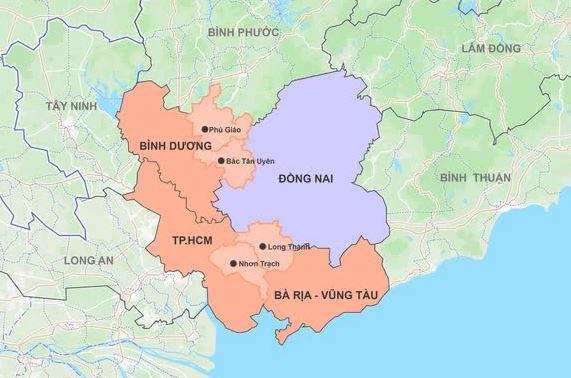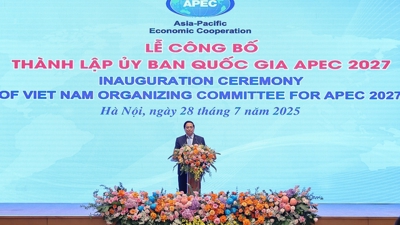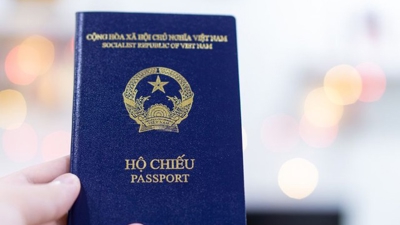Proposed names for 34 provincial-level administrative units after mergers
Under Resolution No. 60-NQ/TW of its 11th plenum, that was held on April 10-12, the 13thParty Central Committee agreed on a policy to restructure provincial-level administrative units across the country, reducing the total from 63 to 34 units, comprising 28 provinces and 6 centrally-governed cities.

Accordingly, the administrative boundaries of Hanoi, Hue City, and the provinces of Lai Chau, Dien Bien, Son La, Lang Son, Quang Ninh, Thanh Hoa, Nghe An, Ha Tinh and Cao Bang remain unchanged.
Meanwhile, 52 other localities will be merged as the following 23 new localtities (names of the newly established provinces or centrally-governed cities are typed in all caps):
1. The province of TUYEN QUANG results from the merger of Tuyen Quang and Ha Giang provinces, with a total natural area of 13,795.6 square kilometers and a population of 1,731,600 people. Its political-administrative center shall be located in present-day Tuyen Quang city.
2. The province of LAO CAI results from the merger of Lao Cai and Yen Bai provinces, with a total natural area of 13,257 square kilometers and a population of 1,656,500 people. Its political-administrative center shall be located in present-day Yen Bai city.
3. The province of THAI NGUYEN results from the merger of Bac Kan and Thai Nguyen provinces, with a total natural area of 8,375.3 square kilometers and a population of 1,694,500 people. Its political-administrative center shall be located in present-day Thai Nguyen city.
4. The province of PHU THO results from the merger of Vinh Phuc, Phu Tho, and Hoa Binh provinces, with a total natural area of 9,361.4 square kilometers and a population of 3,663,600 people. Its political-administrative center shall be located in present day Viet Tri city (of current Phu Tho province).
5. The province of BAC NINH results from the merger of Bac Ninh and Bac Giang provinces, with a total natural area of 4,718.6 square kilometers and a population of 3,509,100 people. Its political-administrative center shall be located in present-day Bac Giang city.
6. The province of HUNG YEN results from the merger of Hung Yen and Thai Binh provinces, with a total natural area of 2,514.8 square kilometers and a population of 3,208,400 people. Its political-administrative center shall be located in present-day Hung Yen city.
7. The centrally-governed city of HAI PHONG results from the merger of Hai Duong province and Hai Phong city, with a total natural area of 3,194.7 square kilometers and a population of 4,102,700 people. Its political-administrative center shall be located in present-day Thuy Nguyen city (Hai Phong city).
8. The province of NINH BINH results from the merger of Ha Nam, Ninh Binh, and Nam Dinh provinces, with a total natural area of 3,942.6 square kilometers and a population of 3,818,700 people. Its political-administrative center shall be located in present-day Ninh Binh city.
9. The province of QUANG TRI results from the merger of Quang Binh and Quang Tri provinces, with a total natural area of 12,700 square kilometers and a population of 1,584,000 people. Its political-administrative center shall be located in present-day Dong Hoi city (of current Quang Binh province)
10. The centrally-governed city of DA NANG results from the merger of Quang Nam province and Da Nang city, with a total natural area of 11,859.6 square kilometers and a population of 2,819,900 people. Its political-administrative center shall be located in present-day Hai Chau district (of current Da Nang city).
11. The province of QUANG NGAI results from the merger of Kon Tum and Quang Ngai provinces, with a natural area of 14,832.6 square kilometers and a population of 1,861,700 people, Its political-administrative center shall be located in present-day Quang Ngai city.
12. The province of GIA LAI results from the merger of Gia Lai and Binh Dinh provinces, with a total natural area of 21,576.5 square kilometers and a population of 3,153,300 people. Its political-administrative center shall be located in present-day Quy Nhon city (of current Binh Dinh province).
13 The province of KHANH HOA results from the merger of Ninh Thuan and Khanh Hoa provinces, with a total natural area of 8,555.9 square kilometers and a population of 1,882,000 people. Its political-administrative center shall be located in present-day Nha Trang city (of current Khanh Hoa province).
14. The province of LAM DONG results from the merger of Lam Dong, Dak Nong, and Binh Thuan provinces, with a total natural area of 24,233.1 square kilometers and a population of 3,324,400 people. Its political-administrative center shall be located in present-day Da Lat city (of current Lam Dong province).
15. The province of DAK LAK results from the merger of Dak Lak and Phu Yen provinces, with a total natural area of 18,096.4 square kilometers and a population of 2,831,300 people. Its political-administrative center shall be located in present-day Buon Ma Thuot city (of current Dak Lak province).
16. The centrally-governed city of HO CHI MINH CITY results from the merger of, Ho Chi Minh City and the provinces of Ba Ria - Vung Tau and Binh Duong, with a total natural area of 6,772.6 square kilometers and a population of 13,608,800 people. Its political-administrative center shall be located in present-day District One (of current Ho Chi Minh City).
17. The province of DONG NAI results from the merger of Dong Nai and Binh Phuoc provinces, with a total natural area of 12,737.2 square kilometers and a population of 4,427,700 people. Its political-administrative center shall be located in present-day Bien Hoa city (of current Dong Nai province).
18. The province of TAY NINH results from the merger of Tay Ninh and Long An provinces, with a total natural area of 8,536.5 square kilometers and a population of 2,959,000 people. Its political-administrative center shall be located in present-day Tan An city (of current Long An province)
19. The centrally-governed city of CAN THO results from the merger of Can Tho City, and the provinces of Soc Trang and Hau Giang, with a total natural area of 6,360.8 square kilometers and a population of 3,207,000 people. Its political-administrative center of the new locality shall be located in present-day Ninh Kieu District (of current Can Tho city).
20. The province of VINH LONG results from the merger of the provinces of Ben Tre, Vinh Long, and Tra Vinh, with a total natural area of 6,296.2 square kilometers and a population of 3,367,400 people. Its political-administrative center shall be located in present-day Vinh Long city.
21, The province of DONG THAP results from the merger of Tien Giang and Dong Thap provinces, with a total natural area of 5,938.7 square kilometers and a population of 3,397,200 people. Its political-administrative center shall be located in present-day My Tho city (of current Tien Giang province).
22. The province of CA MAU results from the merger of the provinces of Bac Lieu and Ca Mau provinces, with a total natural area of 7,942.4 square kilometers and a population of 2,140,600 people. Its political-administrative center shall be located in present-day Ca Mau city.
23. The province of AN GIANG results from the merger of An Giang and Kien Giang provinces, with a total natural area of 9,888.9 square kilometers and a population of 3,697,200 people. Its political-administrative center shall be located in present-day Rach Gia city (of current Kien Giang province).
The merger of cities and provineces will be approved by the National Assembly at its upcoming sitting, scheduled to open in May 5.
Also under the plan, the two-tier local administration system shall include: (i) provincial-level administration of provinces and centrally-governed cities; (ii) commune-level administration of communes and wards.
The district-level and township-level administrations shall be dissolved.







